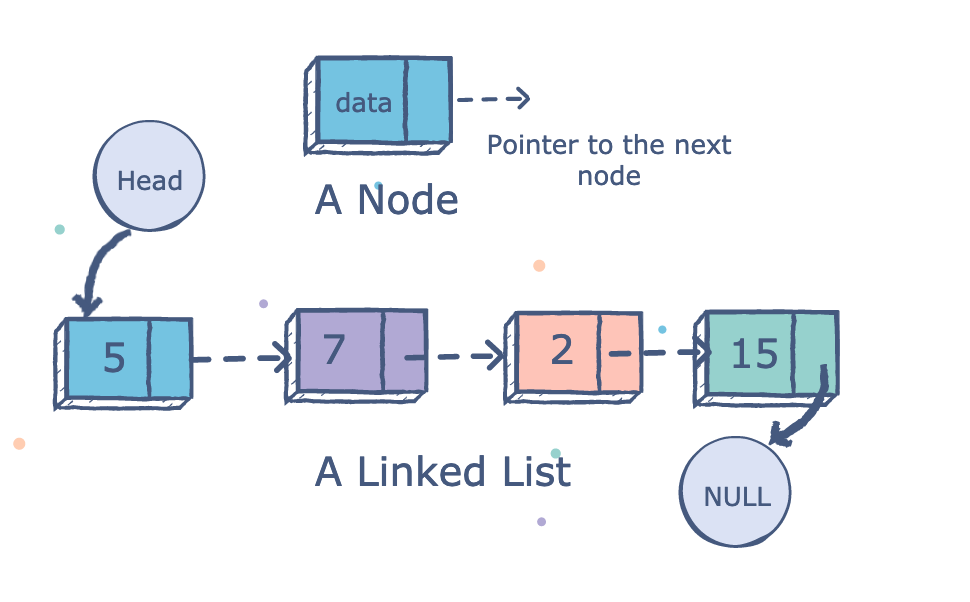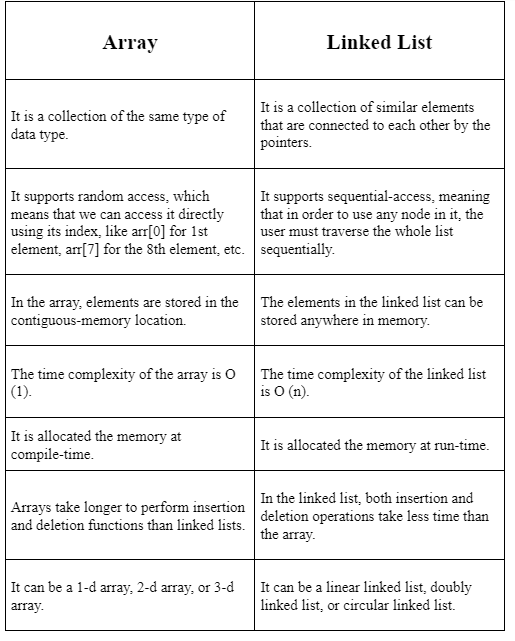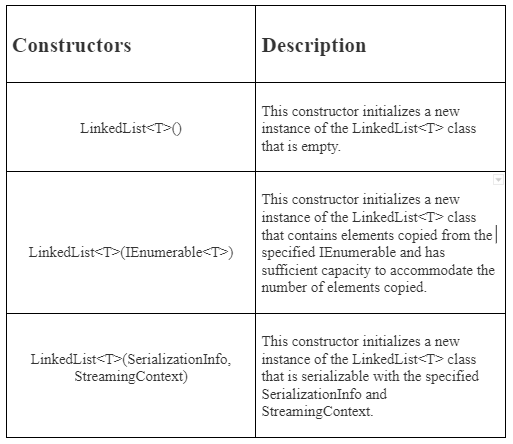
Linked List Implementation in C# Tutorial | Ultimate Guide to Learn [UPDATED]
Last updated on 28th Jan 2022, Blog, Tutorials
- Introduction to LinkedList Collection in C#
- What is the utilization of connected rundown in C#?
- For what reason do we utilize connected rundown?
- What is LinkedList an assortment?
- Sorts of Linked List
- Utilization of Linked List
- Difference between linked list and array
- Significant Points
- How to make a LinkedList?
- How about we perceive how to make a LinkedList utilizing LinkedList() constructor
- How to eliminate components from the LinkedList?
- How to take a look at the accessibility of the components in the LinkedList?
- Advantage of Linked List Collection
- Pre-Requisite’s
- Conclusion
- utilizing System;
- utilizing System.Collections.Generic;
- class Demo {
- static void Main() {
- LinkedList < string > l = new LinkedList < string > ();
- l.AddLast(“one”);
- l.AddLast(“two”);
- l.AddLast(“three”);
- foreach(var ele in l) {
- Console.WriteLine(ele);
- }
- }
- }
- one
- two
- Three”
- The connected rundown is a crude information structure, which is utilized in different kinds of uses.
- It is utilized to keep up with registry names.
- The connected rundown can perform number juggling tasks in the long whole number.
- Polynomials can be controlled by putting away consistency in the hub of the connected rundown.
- We can likewise utilize it to next and past pictures in the picture watcher.
- With the assistance of the connected rundown, we can move melodies this way and that in the music player.
- The connected rundown is likewise utilized for a fix in word and Photoshop applications.
- All the running applications in the PC are put away in the roundabout connected rundown, and the working framework furnishes them with a decent time allotment.
- It can likewise be utilized to execute hash tables.
- The LinkedList class carries out the ICollection<'T>, IEnumerable<'T>, IReadOnlyCollection<'T>, ICollection, IEnumerable, IDeserializationCallback, and ISerializable connection points.
- It additionally upholds enumerators.
- You can eliminate hubs and reinsert them, either in a similar rundown or in another rundown, which brings about no extra articles distributed on the store.
- Each hub in a LinkedList<'T> object is of the sort LinkedListNode<'T>.
- It doesn’t uphold anchoring, parting, cycles, or different highlights that can leave the rundown in a conflicting state.
- On the off chance that the LinkedList is vacant, the First and Last properties contain invalid.
- The limit of a LinkedList is the number of components the LinkedList can hold.
- In LinkedList, it is permitted to store copy components yet of a similar kind.
- utilizing System.Collections.Generic;
- LinkedList <'Type_of_linkedlist> linkedlist_name = new LinkedList <'Type_of_linkedlist>();
- names.AddFirst(“Anakin”);
- names.and last(“Luke”);
- You can likewise embed a worth at a particular piece of the rundown by utilizing an occurrence of a LinkedListNode<'T> that has a place with the rundown.
- You utilize this hub example, as an anchor for putting embedding the worth, either before it or after it.
- To get a case of the hub, you can utilize the Find or FindLast strategy:
- var hub = names.Find(“Luke”);
- names.AddBefore(“Padme”);
- names.AddAfter(“Rey?”);
- Then again, you can make a LinkedListNode<'T> before you add it, and afterward utilize that to secure another worth:
- var hub = new LinkedListNode<'T>(“Luke”);
- // Add the hub
- names.AddLast(node);
- // Add another worth, utilizing this hub
- names.AddAfter(node, “Rey?”);
- names.Remove(“Luke”);//Find the thing and eliminate it.
- names.Remove(node);//Remove the particular hub.
- names.RemoveFirst();//Removes the principal thing in the rundown.
- names.RemoveLast();//Removes the last thing in the rundown.
- <-- [NodeA] <- - > [NodeB] <- - > [NodeC] – – >//Before expulsion
- <-- [NodeA] <- - > [NodeC] – – >//After expulsion
- foreach (string name in names)
- {
- Console.WriteLine(name);
- }
- LinkedList<'T> is a universally useful connected rundown. It upholds enumerators.
- Addition and evacuation are O(1) tasks.
- You can eliminate hubs and reinsert them, either in a similar rundown or in another rundown, which brings about no extra items assigned on the pile.
- Since the rundown additionally keeps an inner count, getting the Count property is an O(1) activity.
- Every hub in a LinkedList<'T> object is of the kind LinkedListNode<'T>.
- The LinkedList class doesn’t uphold anchoring, parting, cycles, or different highlights that can leave the rundown in a conflicting state.
- Assuming the LinkedList is unfilled, the First and Last properties contain invalid.
- The LinkedList is doubly connected, hence, every hub focuses forward to the Next hub and in reverse to the Previous hub.
- The connected rundown is a unique information structure.
- You can likewise diminish and expand the connected rundown at run-time. That is, you can apportion and deallocate memory at run-time itself.
- In this, you can undoubtedly do addition and erasure capacities. That is, you can without much of a stretch addition and erase the hub.
- Memory is very much used in the connected rundown. Since in it, we don’t need to assign memory ahead of time.
- Its access time is extremely quick, and it tends to be gotten to at a specific time without memory upward.
- You can without much of a stretch execute direct information structures utilizing the connected rundown like a stack, line.
- The connected rundown requires more memory to store the components than a cluster, because every hub of the connected rundown focuses on a pointer, because of which it requires more memory.
- It is extremely challenging to navigate the hubs in a connected rundown. In this, we can’t get too haphazardly to anyone hub. (As we do in the cluster by file.) For instance: – If we need to navigate a hub in a position, then, at that point, we need to cross every one of the hubs that precede n, which will pamper a great deal within recent memory.
- Reverse navigating in a connected rundown is truly challenging, because it requires more memory for the pointer.
Introduction to LinkedList Collection in C#:
Many projects require some type of dynamic memory on the board. This need emerges at whatever point it is important to make information structures whose size can’t be resolved statically when the program is being constructed. Search trees, image tables, and connected records are instances of dynamic information structures. A connected rundown is a straight assortment (for example a grouping) of self-referential class objects called hubs, associated by reference joins. A program gets to a connected rundown using a reference to the main hub of the rundown. Each resulting hub is gotten to using the connection reference number put away in the past hub. Information is put away in a connected rundown progressively – that is, every hub is made as needs are. It follows then that a hub can contain information of any sort, including references to different objects of different classes.
The benefit of utilizing a connected rundown over an exhibit is that a cluster can be proclaimed to contain a greater number of components than the number of things expected, conceivably squandering memory. Connected records give better memory usage since they can develop and recoil at execution time, saving memory. The components of an exhibit are put away coterminously in memory to permit prompt admittance to any cluster component. That is, the location of any component in an exhibit can be determined straightforwardly from its list. Connected records don’t empower speedy admittance to their components: you need to navigate the rundown from the front. I’m composing this article to epitomize a connected rundown library that can be utilized by a test program (an extremely fundamental program). The program comprises four classes. We will fabricate it and afterward introduce it into our worldwide gathering reserve:
What is the utilization of connected rundown in C#?
The components in a connected rundown are connected utilizing pointers. Or then again as such, LinkedList comprises of hubs where every hub contains an information field and a reference(link) to the following hub in the rundown. In C#, LinkedList is the conventional sort of assortment which is characterized in the System.
For what reason do we utilize connected rundown?
Connected records are direct information structures that hold information in individual items called hubs. Connected records are frequently utilized due to their proficient addition and cancellation. They can be utilized to carry out stacks, lines, and other conceptual information types.
What is LinkedList an assortment?
The LinkedList class is an assortment that can contain many objects of a similar kind, very much like the ArrayList. The LinkedList class has each of similar strategies as the ArrayList class since the two of them carry out the List interface.
System.Collections.Generic namespace in C#:
System.Collections.The generic namespace is accessible in C# for LinkedList. The LinkedList<'T> class permits the addition and erasure of components from the rundown at a high speed. C# LinkedList<'T> class utilizes the idea of connected rundown. It permits us to embed and erase components fastly. It can have copy components. It is found in System.Collections.Generic namespace.
Output:

Sorts of Linked List:
The sorts of connected rundown are referenced beneath:
Independently Linked List: can be crossed uniquely in forwarding bearing.
Doubly Linked List: can be crossed in forward and in reverse headings.
Roundabout Singly Linked List: The last component contains a connection to the main component as next.
Roundabout Doubly Linked List: The last component contains a connection to the primary component as next and the main component contains a connection of the last component as past.
Utilization of Linked List:
Difference between linked list and array:
Both exhibit and connected rundown are utilized to store similar sort of direct information, yet cluster is apportioned bordering memory area in the assemble time while the connected rundown is allotted memory in run-time.

Significant Points:
How to make a LinkedList?
A LinkedList class has 3 constructors which are utilized to make a LinkedList which are as per the following:
LinkedList(): This constructor is utilized to make a case of the LinkedList class that is unfilled.
LinkedList(IEnumerable): This constructor is utilized to make an occasion of the LinkedList class that contains components replicated from the predetermined IEnumerable and has adequate ability to oblige the number of components duplicated.
LinkedList(SerializationInfo, StreamingContext): This constructor is utilized to make an example of the LinkedList class that is serializable with the predetermined SerializationInfo and StreamingContext.
How about we perceive how to make a LinkedList utilizing LinkedList() constructor:
Stage 1: Include System.Collections.Generic namespace in your program with the assistance of utilizing watchword:
Stage 2: Create a LinkedList utilizing LinkedList class as displayed underneath:
Stage 3: LinkedList gives 4 distinct techniques to add hubs and these strategies are:
AddAfter: This strategy is utilized to add another hub or worth after a current hub in the LinkedList.
AddBefore: This technique is utilized to add another hub or worth before a current hub in the LinkedList.
AddFirst: This technique is utilized to add another hub or worth toward the beginning of the LinkedList.
AddLast: This technique is utilized to add another hub or worth toward the finish of the LinkedList.
Stage 4: The components of the LinkedList are gotten to by utilizing a foreach circle or by utilizing for circle.
How to eliminate components from the LinkedList?
In LinkedList, it is permitted to eliminate components from the LinkedList. LinkedList<'T> class gives 5 distinct techniques to eliminate components and the strategies are:
Clear(): This strategy is utilized to eliminate all hubs from the LinkedList.
Remove(LinkedListNode): This strategy is utilized to eliminate the predefined hub from the LinkedList.
Remove(T): This strategy is utilized to eliminate the principal event of the predetermined worth from the LinkedList.
RemoveFirst(): This technique is utilized to eliminate the hub toward the beginning of the LinkedList.
RemoveLast(): This technique is utilized to eliminate the hub toward the finish of the LinkedList.
How to take a look at the accessibility of the components in the LinkedList?
In LinkedList, you can check whether or not the given worth is available utilizing the Contains(T) technique. This technique is utilized to decide if a worth is in the LinkedList.
Constructors in LinkedList Collection:
The various constructors and their depiction is given as follows:
Table: Constructors in LinkedList Collection in C#
Source: MSDN

Adding things to the rundown:
There are multiple ways of adding things to, not entirely set in stone by where you need to add the thing. Most importantly as the rundown has both a head and a tail, the activities of AddFirst and AddLast are accessible for adding things at these positions:
With that hub, you can then call AddBefore and AddAfter:
Eliminating things from the rundown:
The connected rundown gives the standard Remove technique, however, it likewise gives a few options in contrast to eliminating components at explicit positions:
With any expulsion activity, the rundown needs to refresh the hubs either side of the hub, so they never again point at hub, rather one another:
At the point when you call the Remove strategy, passing the worth you need to eliminate, the rundown plays out an inquiry to find the hub in the rundown that contains esteem. If you call Remove passing an occasion of LinkedListNode<'T>, it will approve that the hub has a place with the rundown, before eliminating it. If the hub doesn’t have a place with the current rundown, then, at that point, it toss an InvalidOperationException.
Circling through the rundown:
Like the other standard assortments, you can utilize the for-each, or while circle to travel through the rundown:
Attributes of LinkedList Collection:
Advantage of Linked List Collection:
Disadvantages:
Pre-Requisite’s:
This type doesn’t string safely. Assuming the LinkedList<'T> should be gotten to by various strings, you should execute their synchronization instrument. A LinkedList<'T> can uphold various per users simultaneously, as long as the assortment isn’t altered. All things being equal, counting through an assortment is naturally not a string safe strategy. In the uncommon situation where count battles with compose get to, the assortment should be locked during the whole list. To permit the assortment to be gotten to by different strings for perusing and composing, you should execute your synchronization.
Conclusion:
This is a manual for C# LinkedList. Here we talk about the idea of LinkedList Collection in C# through definition, punctuation, working, constructors, and their strategies through programming models and their results.

